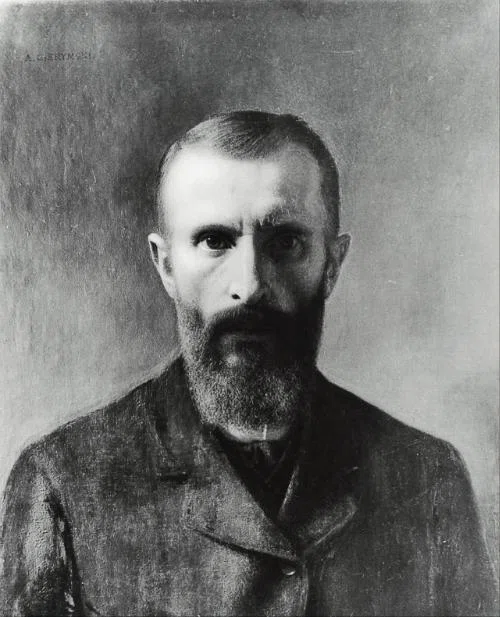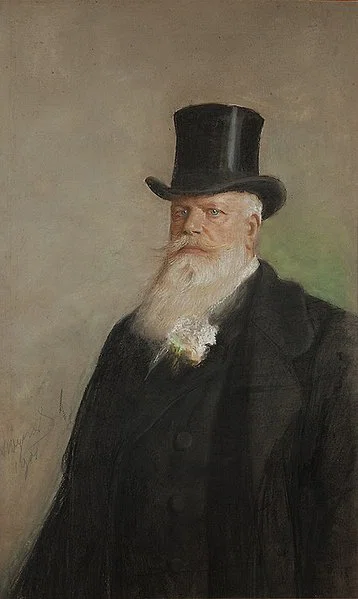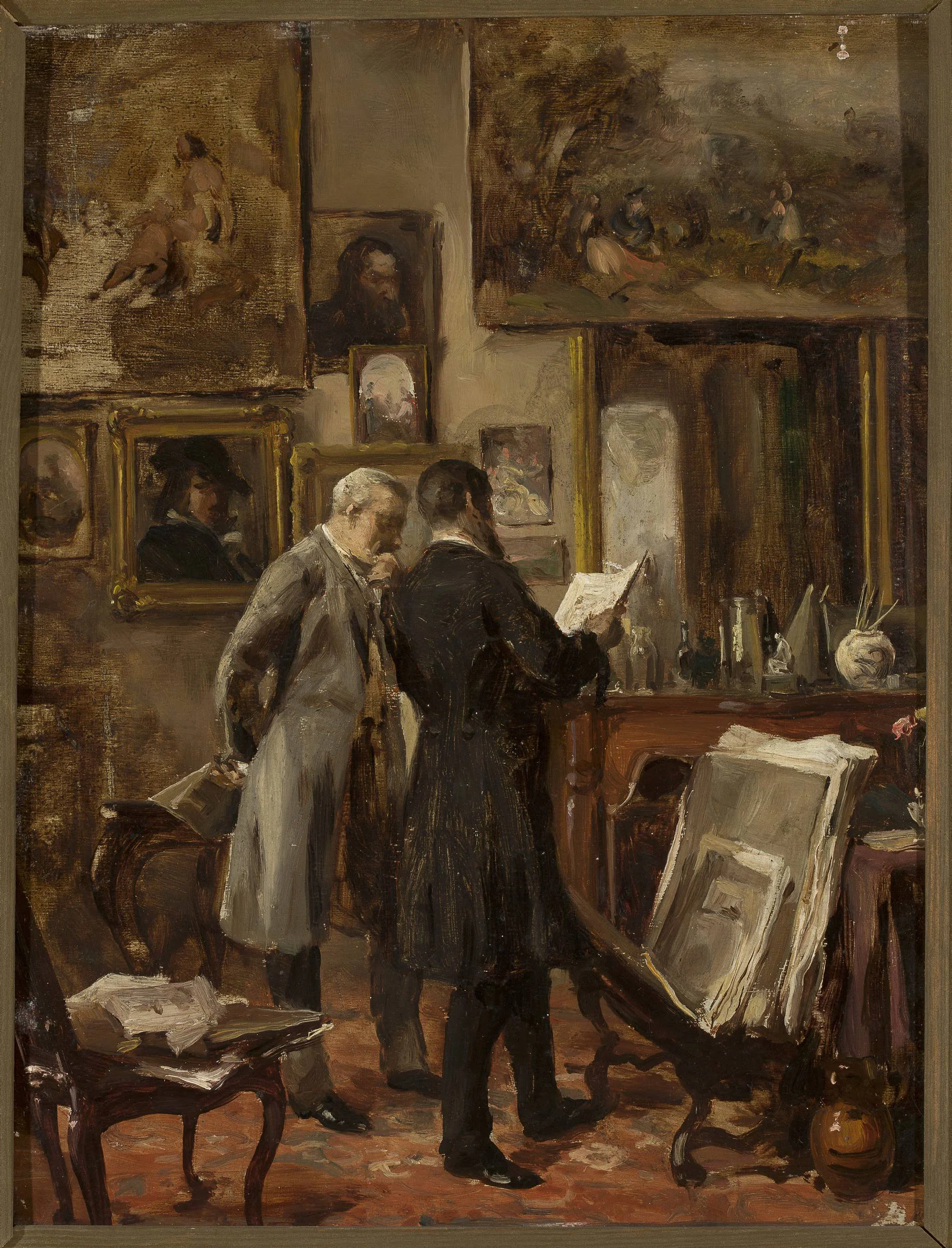To be in the process. About the art of Aleksander Gierymski
The work of Aleksander Gierymski has been rediscovered by art historians, critics and collectors almost a decade ago. Due to the latest state of research and an innovative contemporary analysis of his legacy, this prematurely deceased painter has risen to the rank of the most outstanding artist in our times, although he did not receive adequate recognition in his time. Being one of the most outstanding representatives of realism, a precursor of luminous and color experiments in Polish painting at the turn of the century, and by creating a conscious opposition to the primacy of historical painting, he influenced the concept of elite and egalitarian art in Poland.
This painter, both in the formula of realistic painting and landscape painting, was a seeker and advocate of "pure painting". He was still insatiable in studying the effects of light and color working together. As a result, the painter left behind an innovative artistic legacy, although today we know that Gierymski was constantly dissatisfied with the results of his works and driven by the need to improve "beauty". Criticized for too hard realism and a brutalist vision of the world, he alternately wanted to prove that he can paint more delicate and elegant subjects.

While admiring Aleksander Gierymski's sketch offered in the ongoing online auction, special attention should be paid to the name that appears on the cover of Aleksander Gierymski's drawing - Ignacy Korwin Milewski. This figure is undeniably one of the most important Polish collectors, who surrounded himself with the canonical personalities of Polish painting, and at the same time bought than two hundred canvases by them, including the works by: Aleksander Gierymski, Józef Chełmoński, Józef Pankiewicz, Leon Wyczółkowski, Jan Stanisławski, Jacek Malczewski and Jan Matejko; which are now at the core of the Polish national heritage.

Ignacy Karol Korwin Milewski did not come from a family with great traditions, but with a wealthy financial background, especially thanks to the dowry that his mother, Weronika Wołk-Łaniewska, brought to the Milewski family. Milewski began to accumulate his collection, as he himself enumerated, from around 1880. The collection he collected was the result of methodical searches and contacts with painters of a specific artistic "pedigree". Count Milewski gave the editor of "Kraj" the following statement in 1893:
"Wishing to have a collection that is more or less complete and constituting an original whole, even if it's only modest in size, I have to limit myself to certain frames, and as such I chose a specialty such as the New Pinakothek in Munich. So I purchase paintings by artists-countrymen, now living, and only among those who belong or belonged to the Munich school ".
This painting was distinguished not only by national themes, but also by studying the native landscape with genre scenes woven into it, and by presenting historical compositions. Milewski developed his theory of collecting in 1895 on the occasion of an exhibition of his collections in Vienna:
"Every cultural development is associated with its homeland only for a certain, often short period of time. Thus, at the beginning of the 19th century, Poland issued national heroes, knights and poets, and in the last 30 years - painters who probably will not have their successors. So that these works are not scattered, but are preserved for the Motherland - I am gathering them to testify to the culture of Poland. "
He believed that Munich realism, unlike French art, was soothing to art. The reason for this was undoubtedly the atmosphere of the university in "Mnichów" (as the Poles called Munich), full of appreciation for individuality and sensitivity to the naturalism of the surrounding reality. Milewski wanted "Polish painters to happily combine their national qualities with the realistic art of the Munich school".
Appearing as a true connoisseur and esthete, he kept close contacts with artists, visited them in their studios, ordered paintings from them, paid them generously for their work, and offered constant material care - all to assist in the birth of a painting, which was to be created for the very idea of artistic beauty and the development of national art, and not as an activity that guarantees worldly survival. Undoubtedly, this arrangement was beneficial for both parties - Korwin Milewski, having a liking for contemporary art, did not incur high costs for old art specimens, nor did he risk that an inauthentic work would be added to his collection. In accordance with the theory formulated by himself, the collector included in his collection works that are today considered to be the canon of Polish painting.

However, among all painters, Count Milewski was particularly fond of the talent of Aleksander Gierymski, whom he decided not only to support financially with private orders and purchases of his canvases and sketches, but he also took care of his artistic development by financing trips to Paris. "I have no money, I have no position and I am not doing anything, I have nothing to connect me with people - but I have an artist's ambition that I will not give up for anything" - this is what Aleksander Gierymski said about himself and that power of the painter's character cut through these words attracted the collector the most. The recognition that Milewski had for Aleksander Gierymski meant that he not only conscientiously collected his works, but also paid for them, according to the artist himself, "royally". A trace of this cooperation and contacts can be found in one of Aleksander Gierymski's letters:
"I work a lot; I have five larger and three small paintings to finish before I leave (...).If it weren't for Milewski, who took four small pictures and ordered one bigger picture, I wouldn't have anything to live on"
For this support, Aleksander Gierymski repaid his artistic tutor with sincere dedication and a sometimes made promise that all Milewski's instructions would be included in the composition of the picture. We now know that around 1888, for several consecutive years, Ignacy Milewski regularly paid the painter so he could earn a living, and additionally organized Gierymski's departure from Munich to Paris! In a letter from 1890 to Prosper Dziekoński, Gierymski writes: "(...) Milewski is here temporarily, on his way to London, he will introduce me to the medical celebrity Julien. "What do these words prove? The great care that was given to his beloved artist, not only in the field of painting. In 1891, Gierymski wrote that:" (...) I stumbled onto great difficulties with the picture (Paris Opera at night). As for the sale, at least I'm calm, Milewski takes it on very comfortable terms. If I do not sell it at the exhibition for more money, he will take the painting for the cost of making another one of the same size" It should also be noted that this cooperation did not always run smoothly. In a letter from 1890, Gierymski wrote to Stanisław Witkiewicz:" (...) I am waiting for Milewski, who is supposed to soon come from Berlin, and see the finished painting, still installed in Warsaw, and order a new one with a sea motif. I doubt that the sea motif could be in my talent, for this you need a man born by the sea "(Stanisław Witkiewicz, Aleksander Gierymski, Warsaw 1950, p. 130). Despite misunderstandings in the field of art, Milewski and Gierymski created a very harmonious a duo which today we can say that changed the face of the history of Polish painting The count of Aleksander Gierymski's paintings, including: Trumpets, Jewish Woman with Lemons, Peasant Coffin, Sanders, Angel of the Lord (in Milewski's collection since 1891), Self-portrait with a palette , A boy carrying a sheaf, as well as numerous landscape and genre studies show a great love for art signed by Gierymski.

Ignacy Korwin Milewski, believing that his collection includes valuable pieces of Polish painting from the 19th century, wished to generously offered his large collection to to Polish society. He hesitated whether to present the gift in Kraków or rather in Lviv, where as early as 1894 he had lent a large part of his collection to the exhibition. The choice of destination of the collection was to be influenced not so much by one's own sympathies, but above all by artistic considerations, the safety of the collections and their proper display in a given city. Milewski even wanted to build a "museum" building at his own expense, the only task of the cities was to donate land for construction. However, the lack of a suitable location for the collection and the count's lack of trust in the state care of the paintings meant that soon the talks with the authorities of both cities were broken, and the offended founder left with his collection to Vienna, where in 1895 he organized an exhibition of his collections, which enjoyed a huge interest. Deprived of the possibility of anchoring his painting resources in the country, he embarked on a grand tour so that the European audience could admire the talent of "Polish Munich people". He never returned to Galicia. An affluent life, expensive social initiatives and expensive travels have put Korwin-Milewski into serious financial problems. He lost his estates and movables remaining in the areas covered by Russia. His securities were already worth a fraction of what they were worth before World War I. In 1922, a cerebral hemorrhage partially paralyzed the 76-year-old count. Creditors and ex-mistresses tried to wrest as much as possible from his fortune without hesitating to blackmail. The courts therefore blocked the count's accounts in banks, established sequestration on his property, and seized all the paintings previously deposited in Viennese warehouses.

Meanwhile, Ignacy Korwin-Milewski had nothing to live of, and he used to live beyond his means. He makes the final decision that will help save him from this tragic situation. He decided to sell his collection of Polish paintings! He dreams of selling her entire collection to a single person. This turns out to be even more difficult because he rejects the idea of selling the paintings to the State Collections in Warsaw. The count was supposed to sarcastically describe the situation: "Not only can they only afford to offer ridiculously little money, but they will try to appeal to his patriotism to get the lower price." So he was forced to sell the works individually. As soon as the news spread through the collectors' milieu at the time, art dealers went to the auction in ecstasy. Abe Gutnajer, a Warsaw antiquarian, selected the best works at the Milewski's collection auctions, including those by Aleksander Gierymski, to be exhibited at his Salon in Warsaw. A part of the collection is later purchased by the National Museum in Warsaw, thus becoming the greatest "heir" of Milewski's legacy (today these works are the pride of the 19th century Art Gallery); the rest of the works were taken over by Dr. Emil Merwin, a Viennese attorney, to continue selling, taking part of the profits for himself. The press at that time raised alarms and made appeals to state authorities to prevent one of the most beautiful collections of Polish painting from being dispersed. For reasons including financial reasons, it remained deaf to the words of warning that the country is losing sight of the pearls of Polish art. Thus, one of the most important and beautiful collections - consciously collected - spread to all parts of the world, burying the memory of its creator.

